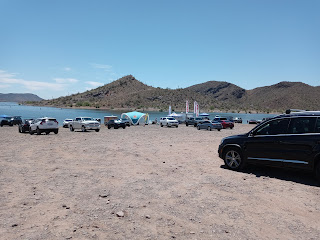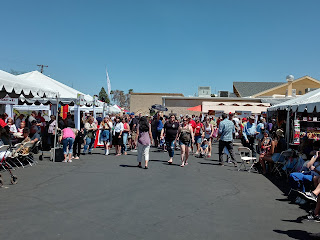Learning to Kayak Class
On Saturday, May 18th, instead of going hiking, I attended the "Learning to Kayak" class given by REI at Lake Pleasant, AZ.
 |
| REI Learn to Kayak Class (Source: REI) |
This was my third attempt at attending this class. Back in December 2024, I had to cancel my reservation due to an operation at the VA Hospital in downtown Phoenix. I then registered to take the class this past April. A week before the class, I received an email from REI informing me that the class had been cancelled due to low enrollment.
The goal of the class is to teach participants the fundamentals on how to use a kayak. According to REI's website, here are the goals of the class.
- Learn how to launch and stay comfortable in a kayak
- Practice the forward, reverse, and sweep paddle strokes
- Get exposure to the fundamentals of on the water safety
Here is the Gear List for the class.
- Required items to bring:
- Sun Protection - Lip balm, sunscreen, wide-brim hats, etc.
- Water Shoes/Sandals - Foot attire that will protect your feet and is okay to get wet. (e.g. Teva, Chaco, Keen (not flip-flops)
- Synthetic Quick Dry Clothing
- Water Bottle
- Personal Prescription Medications - Including, but not limited to, epinephrine auto-injectors for anaphylactic allergies.
- Optional items to bring:
- Lip Balm/Protection
- Sunglasses
- Wide Brim Hat w/ Retainer - Sun protective and safe in case of wind
- Paddling Gloves
- Waterproof Camera
- Towel - Quick Drying and Lightweight
- Swimwear
- Tip for guides - 10-20% of program price is recommended.
- Items provided by REI:
- Dry Bag
- Group First Aid Kit - Our guides carry a comprehensive first aid kit, but you are welcome to bring any personal first aid-items that you prefer.
- Paddle
- Lifejacket
- Kayak
Getting to Lake Pleasant
The "Learning to Kayak" class was being given at Fireman's Cove at Lake Pleasant.
 |
| Fireman's Cove at Lake Pleasant, AZ (Google Earth) |
On Google Maps, getting to Fireman's Cove appears to be relatively easy to do. You drive north on Lake Pleasant Parkway, making a left at State Road 74 (Morristown New River Highway). After several miles, you then make a right at N Castle Hot Springs Road and head north. After five or six miles, you then make a right at Castle Creek Drive. You then follow Castle Creek Drive to Fireman's Cove. REI did place signs along the side of the road at N Castle Hot Springs Road and again at Castle Creek Drive. I don't remember seeing a sign for Fireman's Cove, but I did see a large number of people and parked cars near the beach along Castle Creek Drive. I drove into the parking lot and then noticed the white Ford pick-up truck with the REI logo on the side.
I found the right place.
The most difficult part of the drive to Fireman's Cove was the gridlocked traffic that I encountered on the Lake Pleasant Parkway between Highway 303 and State Road 74. At Highway 303, the Lake Pleasant Parkway truncates into one lane going north and one lane going south. Moreover, the Arizona Department of Transportation was also doing roadwork nearby, causing traffic to tangle up. It was literally bumper-to-bumper traffic all the way to State Road 74. Crazy stuff.
Learning to Kayak
The main guide from REI was named Dave. He said that he lived in Mesa, AZ and came from the REI located in Chandler, AZ. He also said that he was originally from Roanoak, VA and had lived in Washington, D.C. and Seattle, WA. He said that he had been a professional guide for several years. The assistant guide from REI was from Tucson, AZ. His name was Simrin. He said that he had been working as a professional guide since January of this year.
The guides brought hard-shell kayaks with them. The kayaks they brought came in two lengths, 12.5 feet and 14 feet. In contrast, when I attended the sunset kayaking class back in April, also at Lake Pleasant, the REI guides brought inflatable kayaks to use. What are the differences? Well, the inflatable kayaks are difficult to control, yet they rarely tip over. For hard-shell kayaks, the longer and narrower the kayak, the faster it will go. I ended up with a 12.5 foot long kayak to use. The 12.5 foot kayak was a little wider than the 14 foot kayak.
The initial topics covered in the class were the different parts of the kayak, how to hold the paddle, and how to get into the kayak. Dave also covered the basic paddle strokes.
After that, we got into the water. The water felt refreshingly cool. It was a sunny, hot day at Lake Pleasant. At 12:00 PM, when the class started, the temperature had to be close to 100 degrees Fahrenheit. I had trouble signing the release as the table was sizzling hot. Once we got out on the water, you quickly forgot about the heat.
Once we got away from the crowded beach, Dave reviewed the three or four paddle strokes that he had demonstrated on the beach. The entire group spent the next half hour or so practicing the various basic paddle strokes, such as going forward, going backward, and how to turn the kayak to change the direction of travel. As people got more comfortable, the group went past the No Wake buoys and approached the main part of Lake Pleasant. However, we stayed within sight of Fireman's Cove. We encountered waves caused by speed boats passing by. We also experienced having to deal with both the water current and the wind constantly changing direction. It was a challenge.
At around 2:30 PM, Dave asked the group if people wanted to continue kayaking for the next half hour or return to the beach. I wanted to stay out on the water. I guess I was in the minority as the group headed back to the beach. However, there was a twist. We were supposed to try kayaking backwards as far as we could. The wind and current kept taking me off course, so I turned around my kayak and began to paddle forward.
Camera Problems
During the kayaking class, I had ALL KINDS of problems with the camera app on my cell phone. The user interface on my cell phone would freeze. When I tried to open the camera app, I would get a black screen. I also had problems zooming in and out. Then, I would have problems with the waterproof case I kept my cell phone in as I kayaked. As a result, I didn't take many photos during the class. I know, it's time to seriously consider getting a new cell phone. While I am thinking about it, it's probably time to see if I can find a new waterproof case for my cell phone.
Anyway, here are the photographs that I took as disappointing as they are.
 |
| REI Trailer Truck |
 |
| REI guide Simrin loading kayaks from the morning class. |
 |
| Desert Breeze Kayaking Tours |
 |
| View of Fireman's Cove 1 |
 |
| View of Fireman's Cove 2 |
 |
| View of Fireman's Cove 3 |
 |
| View of Fireman's Cove 4 |
In Conclusion
Was the "Learning to Kayak" class worth the $119 (for REI members) that I paid? Yes, it was. The two guides, Dave and Simrin, were great. They were friendly, approachable, and good at explaining the subtle techniques of learning to kayak. Dave was especially fun as he had lived in the Washington, D.C. area for several years and had been to Baltimore several times. He even agreed with me that the Phoenix metropolitan area DESPERATELY needs a subway. Anyway, given my previous kayaking trips along the Potomac and Monocacy Rivers, the "Learning to Kayak" class was a really good refresher on the basics. If you haven't been kayaking before, then I would highly recommend taking the class. As it just so happened, there is a kayak rental place at Fireman's Cove called Desert Breeze Kayaking Tours. Definitely a place worth checking out.



































































